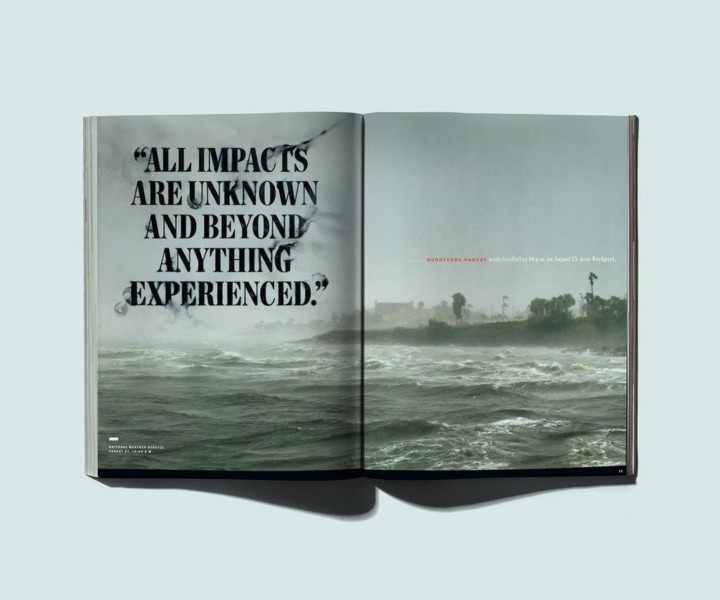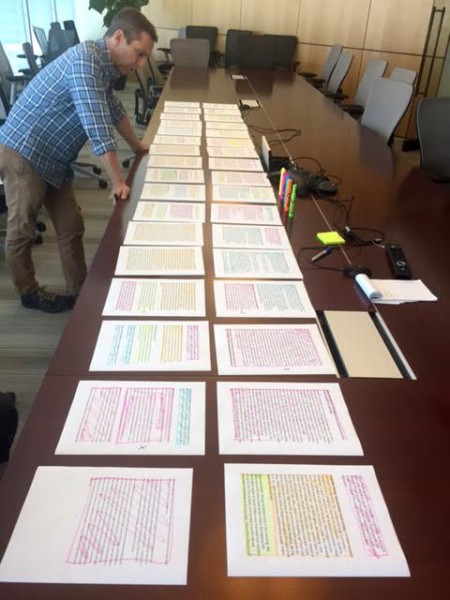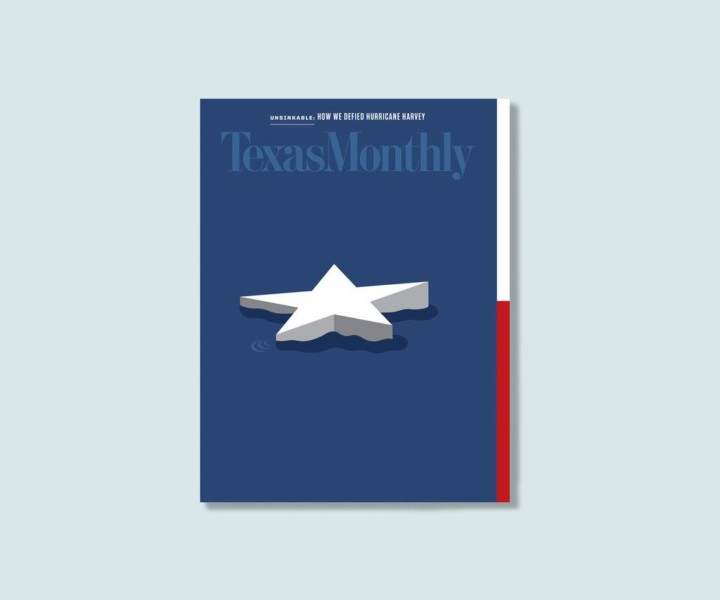When Hurricane Harvey struck Houston late last month, the Texas Monthly team was in the third week of its four-week production cycle. Usually, that’s when the magazine wraps up the issue. But the story of the storm was too big and too important not to tell. “It became increasingly clear that we could not in good conscience not do something big on this,” says Editor in Chief Tim Taliaferro.
So on Monday, August 28, Taliaferro called an emergency editorial meeting. He and his staff scrapped the entire feature well of its music-themed issue and spent the next 10 days putting together an issue mostly dedicated to Harvey. Texas Monthly’s October issue, “Unsinkable: How We Defied Hurricane Harvey,” hit newsstands late last week.
ICYMI: 7 examples of amazing journalism published by Playboy
“It was a question of, ‘What could we pull off?’” Taliaferro says. He and his fellow editors came up with something no one else had: an exhaustive oral history. The resulting feature, “Voices from the Storm,” became the backbone of the issue.

The Texas Monthly compiled an exhaustive oral history of the storm.
Over the years, oral histories have become a signature of Texas Monthly. One in 2006, led by former executive editor Pamela Colloff, reflected on the 40th anniversary of the Charles Whitman shootings at the University of Texas Tower. For “Voices from the Storm,” Taliaferro deployed several reporters across different geographies, from Houston to East Texas to the coastline. He thought Texas Monthly could build on great local coverage including in the Houston Chronicle and Victoria Advocate.
The 13,000-word feature included firsthand accounts from 28 Texans, collected and compiled by a 19-person team. The Texas Monthly team spend the whole week gathering the oral histories of more than 60 people. Their approach was straightforward. They asked residents what happened, chronologically: where they were during storm, what decisions they made (and why), and, of course, to share anecdotes. “Something felt dignified about letting people tell their own story,” Taliaferro says. “The resulting story told through the people who experienced it is just richer than anything we could have reported out and written for the magazine.”
It was a Herculean effort from the magazine’s staff of more than 50 people. One reporter, R.G. Ratcliffe, offered to rent a car and head straight to Rockport, where the storm came ashore. Another, Leif Reigstad, left for Port Arthur and Beaumont shortly after. Texas Monthly already had three reporters based in Houston. The remaining reporters and editors were assigned different cities and towns affected by the storm, as well as tasked with following up on leads from reporters in the field. Interns transcribed the interviews at a furious rate. The point people for the package, Jeff Salamon, deputy editor, and Dave Mann, features editor, compiled, edited, and structured the interviews into a larger narrative on the fly. A draft was ready by Friday, September 1, and by the following Tuesday, it was finalized. “Usually, features are edited and ready for fact-checking two to three weeks before deadline,” Mann says. “In this case, our feature was edited and done three days before.”

Jeff Salamon, deputy editor, looks over the magazine’s new feature well.
Taliaferro also assigned ancillary stories as to complement the oral history. Mimi Swartz, in addition to contributing to “Voices,” penned an essay about how Texans need to plan for the storms to come. Tom Foster compiled a reported Q&A on why another Harvey is likely to happen in the future. And Taliaferro himself reworked his editor’s note into an explainer of the Harvey-centric issue. All these stories were sent off to the printer on Thursday, September 7. Meantime, the Texas Monthly team churned out stories about Harvey for its website.
“We wanted to memorialize the damage that it had done to the state, but also to memorialize the way Texans responded to the storm,” Mann says. “There’s something about the character of the state that came out in this tragedy and we wanted to show that.”
Editorial content wasn’t the only challenge; coming up with new advertising, art, and design elements also posed problems. The sales side had to revisit all its advertisers for the planned issue and tell them the music theme was being scrapped. Taliaferro says advertisers can get skittish when it comes to disaster coverage (though only one pulled its ad from the issue). At the same time, the creative team scrambled on a new cover, plus layouts and art for the feature well. The “Voices” spread spanned 20 pages, interspersing photographs of the storm among the oral histories. As you scroll through the story online, photos of people, destruction, and relief efforts pop up, alongside a chronology of the oral histories from August 20 through 29. Emily Kimbro, the magazine’s design director, relied on photography from outlets like Getty and the Associated Press, as well as original visuals captured by freelancer Darren Braun.

Texas Monthly‘s Hurricane Harvey cover.
For the cover, the magazine wanted to capture both the devastation and how people responded to it. “Some people really lost everything, and we didn’t want to cheapen that by sounding insensitive,” Taliaferro says. “On the other hand, it really was an incredible moment.” Texas Monthly turned to one of its regular illustrators, Dirk Fowler, to memorialize the event. After many conversations and mockups, they settled on a straightforward, symbolic design.
In the span of four days, Fowler crafted an illustration with a lone star floating over a body of water. The intended message? Texas is unsinkable. To emphasize that, he paired the minimalist design with the words, “Unsinkable: How We Defied Hurricane Harvey.” It’s an aesthetic both tragic and empowering, much like the situation in Texas.
ICYMI: Oof! Here are headlines editors probably wish they could take back
Meg Dalton is a freelance journalist and audio producer based in Connecticut. She's reported and edited for CJR, PBS NewsHour, Energy News Network, Architectural Digest, MediaShift, Hearst Connecticut newspapers, and more. Follow her on Twitter: @megdalts. Find her on Twitter @megdalts.

